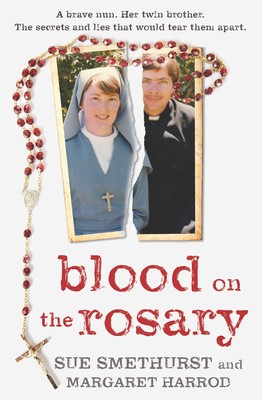Authors: Sue Smethurst and Margaret Harrod
Publisher/Year: Simon & Schuster/2019
Publisher Blurb
A heartfelt, brave and inspiring memoir about the power of speaking out
A brave nun. Her twin brother. The secrets and lies that would tear them apart.
There is a special bond that twins share, an ethereal connection that can’t be put into words. Margaret Harrod shared that unique bond with her twin brother Michael. As children they were inseparable and at age 22, together they gave their lives to the Catholic Church. Margaret became a nun and Michael a Salesian priest – it was the proudest day of their deeply religious parents’ lives.
Margaret cherishes those carefree childhood memories because the brother she adored is now in jail. Father Michael Aulsebrook pleaded guilty to multiple charges of molesting children, some as young as seven. And the unlikely whistleblower was his courageous twin sister.
It cost Margaret everything, but she couldn’t stay silent any longer about the damage her brother was wreaking in his community. Margaret knows of that damage firsthand, having had that trust betrayed herself.
Blood on the Rosary is Margaret’s story – how she sacrificed everything she held dear in the pursuit of the truth, and how she bravely fought her church and her community to bring paedophile priests to justice.
Reviewer: Tara Mitchell
Child abuse, especially the kind perpetrated by the Catholic Church, has hit the headlines in a big way in Australia recently. If you’re at a loss to understand how such behaviour became institutionalised and, more frighteningly, accepted, you must read this book.
Whilst the subject matter is bleak and uncomfortable, Margaret Harrod and Sue Smethurst tell the story in an approachable way for the reader. There is a noticeable absence of graphic details but enough hints throughout the book that your own imagination paints the picture.
Margaret devoted her life to the Catholic Church, as did her twin brother Michael, which made their deeply religious family immensely proud. However, their motivations for entering and staying in the Church couldn’t have been more divergent. Margaret’s attempts to escape her own personal hell living in the family home only led her deeper into darkness. It seems Michael inherited his father’s temperament and found the Church accepting, even encouraging, of his seeking out the company of young children under the guise of mentorship.
As Margaret’s loyalty to the Church slowly unravelled, so too did the threads of her family. Michael’s actions became more and more abhorrent to Margaret, to the point where she could no longer stay silent. Her bravery and fortitude in reporting her own brother for abusing children in his care cost her everything, but the peace and comfort it brought to her are made obvious to the reader.
Margaret’s story is particularly powerful, as it highlights the generational impact of family and institutional abuse. Her bravery in breaking the chain and sharing her ordeal in this compelling and important book cannot be underestimated. Not only does it shine a light on the insidious horrors of abuse, it inspires survivors to find their own strength and resolve in seeking justice.
As I finished the book, I expected to feel great pity for Margaret and the tragic events she endured, both professionally in the Church and in her family life. Instead, I felt a tremendous sense of admiration and reverence for this incredibly brave woman.
